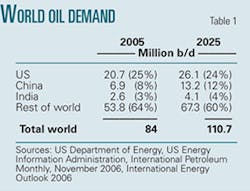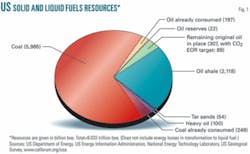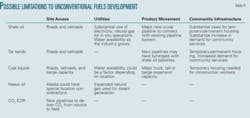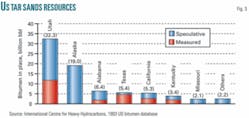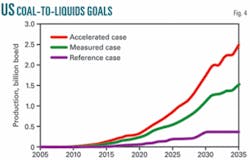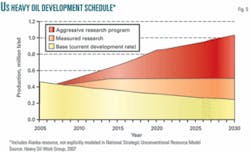The US government and oil industry must jointly take aggressive action to slow the growth in oil demand and to increase oil supply with help from unconventional sources, reported the Federal Task Force on Strategic Unconventional Fuels in September.
The higher cost and volume of US crude and product imports, the task force charged, have exacerbated the nation’s trade deficit, weakened the dollar against other currencies, and put national security and economic stability at risk.
At the same time, international competition for oil supply is intensifying, and “increasingly unstable sources pose strategic risks that the nation can ill afford to ignore,” it said. Global oil demand is expected to increase to more than 110 million b/d by 2025 from 84 million b/d in 2005. US accounts for one fourth of that total (Table 1). During 1985-2004, US demand for oil increased by 25% to 20 million b/d, and imports more than doubled to over 12 million b/d. The Energy Information Administration (EIA) projects that US oil and products imports will increase to 18 million b/d (65% of demand) by 2030.
In response, the task force-established by the Secretary of Energy under Section 369 of the Energy Policy Act of 2005 (EPACT)-completed in February an integrated strategy to accelerate commercial development of unconventional fuels such as oil shale, tar sands, heavy oil, and liquids-from-coal and to implement methods of enhancing US oil recovery (OGJ Online, Aug. 20, 2007).
The task force evaluated the global and US oil supply outlook and assessed domestic unconventional fuels resources that could augment supply (Fig. 1).
It then described a plan for developing an unconventional-fuels industry that it said could supply all of the Department of Defense’s domestic fuels demand by 2016 and add as much as 7 million boe/d of liquid fuels to US markets by 2035 (Fig. 2).
Aggressive implementation could displace imports worth $16-33 billion/year in 2015 and $32-133 billion/year in 2035 (Table 2).
According to the task force, reducing the annual cost of imported oil and products could increase the US gross domestic product (GDP) by $133 billion and contribute $29 billion to net annual direct public industry revenues from rents, royalties, and corporate and individual taxes. “Expected direct program outlays are estimated to be on the order of $3 billion,” the task force said.
Incremental production goals for 2035 include 2.5 million b/d from oil shale, 530,000 b/d from tar sands, 2.6 million b/d from coal liquids, 750,000 b/d from heavy oil, and 1.3 million b/d from enhanced oil recovery via carbon dioxide injection.
Although the task force expects industry to develop most of the unconventional fuels, it identified options that federal, state, and local policy-makers can employ as incentives to encourage public investment and speed development (Table 3).
The task force also examined environmental considerations, markets, carbon management, and the socioeconomic ramifications of each plan.
Constraints on investment
Saying that development of an industry able to produce large amounts of unconventional fuel might require 20 years, the task force identified these constraints on investment:
- Access to resources on public lands, particularly for oil shale, tar sands, and coal resources.
- Economics, high capital and operating costs, unfavorable tax and fiscal regimes, oil price volatility, and long lead times before payback.
- Technology readiness, performance, and efficiency. Technologies that require further advancement or demonstration at commercially representative scale.
- Environmental requirements, permitting processes and timelines, water supply, air quality, and carbon management.
- Uncertain regulation, other permitting processes, and timelines that impact planning and increase costs.
- Socioeconomic risks on affected states and communities that must be mitigated before development can begin.
- Oil price and market risks. Assured markets and long-term offtake commitments that provide a minimum rate of return to secure project financing.
- Requirements and availability of basic support structures such as railroads and pipelines and water to support industry development, operations, and population and economic growth.
All of the constraints require public attention, the task force said (Table 4).
It recommended action, in many cases by government and industry working jointly, in resource access, technology, development economics, environmental protection, water-resource stewardship, socioeconomic effects, regulations and permitting, transportation, markets, government organization, and assessments of benefits and outlays.
Oil shale
The US has a shale oil resource estimated at 2 trillion bbl, primarily in Colorado, Utah, and Wyoming (see map, OGJ Aug. 9, 2004, p. 16). The task force targets production of 2.5 million b/d of shale oil by 2035, which requires a major commitment by the industry and the local, state, and federal governments.
Assuming a long-term oil price of $35/bbl, a $5/bbl production tax, and development of high-risk, cost-shared demonstration projects, the task force says production could begin in 2010 with about 40,000 b/d as the new technology is tested. Later improvements would boost production to 250,000 b/d by 2014, 2 million b/d by 2025, and 2.4 million b/d by 2030.
Technology used to develop shale oil is similar to that of Canada’s oil sands: mining and ore preparation, extraction, coking and retorting, and upgrading, along with environmental mitigation.
All analyses are based on the National Strategic Unconventional Resource Model (NSURM) developed for the task force by the Department of Energy’s Office of Petroleum Reserves.
Oil shale deposits also underlie much of the eastern US from Mississippi to New York, with near-surface mineable resources estimated at 423 billion bbl. Of that total, 98% is in Kentucky, Ohio, Tennessee, and Indiana. With processing technology advances such as the addition of hydrogen to retorting, potential oil yields could approach those of the western shale. Eastern shales are close to major demand centers, which would reduce transportation costs.
Nearly 80% of the western oil shale resource is on public lands managed by the Bureau of Land Management.
Other actions needed for oil shale development:
- Undertake a comprehensive study of the eastern oil shale potential.
- Assure access to oil shale resources on public lands sufficient to meet industry needs and national goals.
- Develop a leasing strategy to determine optimal lease block configurations, as lease holdings currently are too fragmented.
- Resolve conflicts with natural gas production and other surface uses that may conflict with oil shale development.
- Craft a fast-track technology program to attract capital investment.
- Support demonstration of efficient first-generation technologies while carrying out parallel efforts to develop and demonstrate the next generation technology.
- Prepare a plan to assure markets for initial production.
- Meet or exceed public standards and requirements for environmental protection.
- Provide an inclusive regulatory system and review process that allows expeditious development and a predictable schedule for permitting.
- Assess requirements for regional upgrading facilities to bring the oil to pipeline quality, and determine the need for additional pipelines and refining facilities as production increases.
Tar sands
With the exception of about 2,700 b/d produced in situ from four California fields, oil is not currently produced from tar sands in commercial quantity in the US. However, interest in US tar sands is high, and the program goal is to produce 350,000 b/d by 2035. The first planned milestones will be two or three small, economically viable ventures producing bitumen or asphalt followed by several larger integrated plants manufacturing synthetic crude.
Of the estimated 60-80 billion bbl of tar sands oil in the US, about 11 billion bbl may be recoverable. Utah has 19-32 billion bbl of measured tar sands, about one third of the domestic resource, with the balance in Alabama, Texas, California, Kentucky, and other states. Alaska is thought to have 19 billion bbl of tar sands resources (Fig 3).
New extraction technology approaches may be required for US tar sands, which differ in quality and grade from tar sands in Canada, where established methodologies have been in place for 35 years and where technology has greatly improved. Canadian production is about 1 million b/d, including both mining-based and thermal production (OGJ, Aug. 9, 2003, p. 16).
US tar sands are oil-wet and consolidated, with variable and unpredictable grades, and achieving production goals will require activity in technological, fiscal, and institutional areas, said the task force.
The viscosity of the bitumen, which distinguishes tar sands from extra heavy oil, may require some tar sands deposits to be mined.
A constraining factor, then, is the location of Utah tar sands on state and federally owned lands, some of which overlie oil and gas deposits and others that are in or adjacent to national or state parks, wilderness areas, or pristine environments where mining would be precluded or constrained.
Vapor extraction, which can be used with vertical or horizontal wells, is being explored but has not been field-tested. Cold production technology may apply where sand content is high. It requires much drilling but is more economic than thermal processes. To assure an adequate technology base, several technology approaches must be pursued, with use depending on the site.
University research is planned for basic and bench-scale studies. Two 66% federal cost-shared pilot plants are planned in the first year with two additional plants in the second year. In addition, 33% federal cost-shared semiworks and demonstration plants are envisioned.
Tar sands development is constrained as well by market risks, including the ability of existing refiners in target markets to absorb additional quantities of synthetic crude.
Coal-to-liquids
Coal is the most abundant fossil fuel in the US, with recoverable reserves estimated at 267 short tons, broadly distributed (see map). Based on current production of nearly 1.1 billion short tons/year, the US has a 250-year supply. That likely will increase as coal mining technology improves and additional geological data become available.
EIA’s 2006 Annual Energy Outlook for the first time projects a developing market for coal liquids. By 2030, it said, coal liquids will provide 760,000 b/d (reference price case) or 1.69 million b/d (accelerated case; Fig.4).
The goal is for federal, state, and local governments-cooperating with NGOs in a “Manhattan project” type crash program-to stimulate and assist private industry development of a coal-to-liquids (CTL) industry. The governments would set an oil floor price to minimize the risk of a prolonged oil price collapse; provide economic incentives such as tax credits, and loan and purchase guarantees to accelerate development; and participate in early design feasibility studies, engineering design, and permitting for first-of-kind projects.
Large quantities of coal would have to be mined and transported. Congress would be urged to fund the needed transportation system expansion.
Coal can be converted into liquid fuels via direct liquefaction or by indirect liquefaction after gasification. Already, 14 proposals for commercial CTL projects have been announced in the US, although none has been built.
Although Sasol Ltd. has four pilot plants in South Africa that have successfully been using coal liquefaction technology since the 1950s, no commercial plant has been built that combines and integrates advanced coal gasification with advanced Fischer-Tropsch synthesis technologies. A 50,000 b/d plant is estimated to cost $3.5-4.5 billion to build. A strategic CTL industry might produce 2.6 million b/d of liquid fuels from coal by 2035.
A National Coal Council survey has shown that the mining industry and US transportation facilities can be expanded to accommodate growth in coal production by more than 2.3 billion tons/year by 2025. However, the US lacks facilities to build CTL plant components.
Heavy oil
The goal for a heavy oil research and development program is to stimulate private industry development of heavy oil resources-much of it in California, Alaska, and Wyoming-to increase domestic production to as much as 1 million b/d by 2025 (Fig. 5). The cumulative contribution to GDP would total $108 billion through 2030.
Considerable expansion of production technologies will be required. Use of steam injection, in situ combustion, cyclic steam injection, and more-advanced technologies involving horizontal wells, nonthermal recovery technologies, immiscible CO2, and advanced thermal EOR could increase recovery of heavy oil, the task force said, particularly from Alaska’s North Slope, which holds 25-40 billion bbl.
Given declining conventional North Slope oil production, heavy oil production would have to be accompanied by upgrading or the addition of diluent to allow the oil to be transported through the Trans-Alaska Pipeline System.
Program activities would include “basin-specific” public-private partnerships in key heavy oil basins and initiation of a collaborative effort with Canada, such as technology-sharing and jointly funded field research and development.
Enhanced oil recovery
Producing “stranded oil” from maturing fields with CO2 for EOR could add more than 2 million b/d of production by 2035, according to task force projections. It would be accomplished with a basin-oriented approach toward 10 basin studies conducted by the DOE Office of Oil and Natural Gas.
A major element would be to expand the supply of CO2, mostly from industrial sources, in a two-pronged benefit that would also reduce the amount of CO2 released to the atmosphere. An improved, cost-effective technology would be developed to capture and supply “EOR-ready” CO2.
Demand reduction
No single fuel source, however, is likely to substantially reduce the country’s dependence on imported oil, the task force said. Despite adding the incremental supply from unconventional fuels development, the volume of net imports in 2035 would be only slightly reduced because of increases in demand (Fig. 2). Consequently, reducing demand must also be part of a strategy for lowering US oil imports.
The most likely place for efficiency gains relative to liquid fuels is in individual transportation. Increased vehicle mileage and reduced driving, the task force said, could lower net miles driven by 20% in 30 years in a moderate case and 30% in an accelerated case.
The full report is at www.unconventionalfuels.org.

